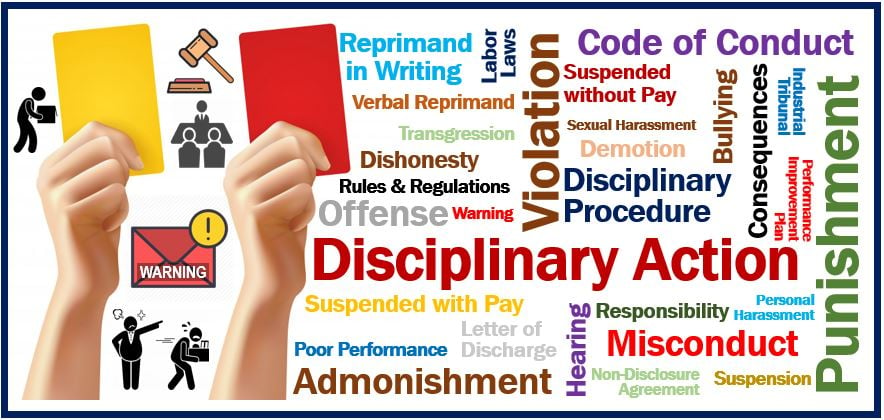An electrical worker refuses to take safety precautions while wiring several residential lots. These oversights presented immediate risks of electric shock, resulting in 40 complaints. As a result, he had his license suspended for a period while he corrected the errors under strict supervision.
The scenario painted above typifies the concept of disciplinary action, but that is just one aspect of it. Disciplinary actions can be taken at work, in school, at home, and in any other scenario with laws and governing bodies.
Many organizations have a disciplinary procedure template, and an employee has to fill a disciplinary action form when joining the team. Regulatory bodies can take corrective action on people in many other forms. But before we delve into them, let’s first understand disciplinary action.

What is disciplinary action?
Disciplinary action is a corrective action or a reprimand issued when an employee has violated a rule, been involved in misconduct, or performed poorly. It usually comes in different formats, depending on the case’s severity. For some people, disciplinary action is verbal, while others opt for written reprimands.
The action taken ranges from slaps on the wrist to more severe punishments like retrenchment. When there is misconduct at work, most employers opt to discipline the defaulter(s).
Is disciplinary action necessary?
We often break the rules either mistakenly or deliberately, and when these offenses are not punished, we often repeat them. So, every institution needs disciplinary actions to reduce misconduct and increase professionalism among its staff.
Without disciplinary actions, chaos rules. So it is necessary to uphold punishments for breaking guidelines to ensure a disciplined workflow.

Disciplinary actions – examples
Having seen why disciplinary action is necessary, let’s look at common ways to chastise your staff after misconduct.
Letter of written reprimand
A formal warning letter is necessary in cases when a verbal warning has already been issued. In other cases, it is written when management deems misconduct to be serious. But it is always clearly written to ensure that a record of the admonishment exists in the company.
Before delivering a written letter of reprimand, a meeting is held with the recipient. This meeting follows a specific format that could be pre-planned using a disciplinary meeting template, which expresses the employer’s displeasure. Besides, some firms require the employee to accept the letter and sign it to take responsibility and show remorse.
Before issuing a written reprimand, you must meet with the defaulter since they deserve to know why they are getting the letter. You could also highlight the employee’s strengths before reprimanding them, although this action is subjective.
If the issue has been addressed before via verbal reprimand, include this in the letter. Firmly state the organization’s stance on such matters, and end the letter by outlining the consequences of their actions.
Letter of suspension
A suspension letter doesn’t just drive to punish a person for an offense; it also should deter the person from repeating it. If there is an expected course of action from the employee, the employer should include it in the letter.
Before a letter of suspension is issued, there should have been a prior warning. Alternatively, serious transgressions can warrant an outright suspension if the regulatory bodies deem it fit. A disciplinary action form is filled in those cases, and a copy is kept in the employee’s file.
Usually, when an employee is suspended, they get paid for the duration of the suspension, except they have a contract clause that states otherwise. However, suspensions rarely exceed 30 days except in health-related cases.
A letter of suspension must follow the disciplinary action template of the organization. It must outline the duration with clear start and end dates. Other things expected in a suspension letter are the misconduct, its effect on business, and future consequences.
Finally, the employee should have a chance to appeal this action.
Disciplinary Demotion
When there is a case of poor performance, even after reprimands and verbal warnings, an employee may be demoted. A demotion often happens when the misconduct is directly related to the person’s ability to execute their jobs.
For instance, a restaurant manager can promote someone from a dishwasher position to a waiter. But if they consistently underperform, they can be moved back to dishwashing.
Disciplinary demotions are rarely punishments for a different kind of misconduct. A demotion is often due to incompetence. And the best way to prove an employee’s competence is to measure their productivity and document unsatisfactory performance.
Demotions may be temporal or permanent, depending on the employer’s assessment. For temporal demotions, the management expects the employee to return to the drawing board like Alex Ferguson and prove themselves worthy of reinstatement.
Before a demotion, human resources managers can issue a reprimand based on a written warning template. When these warnings are ineffective, they can write a disciplinary action letter. The letter should outline the employee’s inefficiencies and the chosen corrective action.
It should also state if the demotion is permanent or not. If it is temporal, the employee reserves the right to know the terms of reinstatement. Disciplinary demotion isn’t the easiest decision to make or execute, but it is often necessary to maintain discipline within the company.
Letter of discharge
If an employee doesn’t improve after you’ve taken all the disciplinary actions mentioned above, a letter of discharge is in order. But you mustn’t go through all other types of disciplinary actions before discharging someone. In some cases, the misconduct’s severity may warrant instant dismissal.
Before issuing a letter of discharge to an employee, endeavor to meet with them in person. It is best to have them sign a disciplinary form. The employee must know beforehand that they are getting a letter of dismissal.
Specific laws protect an employee’s rights to being notified about their release from an establishment. You must notify employees 30 days in advance before severing ties with them in some places. If you get a rush of blood and eject your staff without informing them, they can appeal the decision.
Apart from these rules, many people agree that it is more empathetic to inform someone before letting them go as it cushions the blow. Simply put, it is just the human thing to do.
A letter of discharge should follow a pre-written disciplinary letter template. The date of dismissal, reason, and consequences should be in a discharge letter. It should also state if the misconduct is a one-time event or a gradual cumulation of wrongdoings.
Finally, let employees know if they can appeal your decision to discharge them. A letter of discharge is often the last resort for employers, as many would rather see employees improve. But when the grievance is severe, dismissal may be the best decision for the business.
In conclusion
Disciplinary actions are not fun for the issuer or the person at the receiving end. However, they are necessary to ensure order in the workplace. Before taking disciplinary actions, ensure that there are guidelines to prevent abuse of power. And when employees default, mete out judgment fairly.
Feel free to choose one or more disciplinary actions from this article when reprimanding an erring staff. But no matter which ones you opt for, always keep the window of appeal open in line with your state’s labor laws.
Interesting related article: “What is HR?“

